Uście Gorlickie
Where multiculturalism blooms
The area of Uście Gorlickie Commune spreads over the Low Beskids – one of the lowest mountain massifs in the Carpathians but, at the same time, one of more interesting ones. Despite its tragic, post-war history, the commune is still known for its multiculturalism and living Lemko traditions. Annual ‘Watra’ (Watchfire) in Zdynia gathers Lemko people from all over the world and gives a unique chance to experience the richness of Lemko folklore.

Despite the fact that it is a mountainous area, one may find more attractions in the valleys. The villages hide pearls of wooden architecture, including Greek or Eastern Orthodox churches – some of them still function as Eastern rite churches. You can come across even a Hutsul Orthodox church in Gładyszów. Shrines and crosses stand by the roads. There are cemeteries from the period of the First World War on wooded hill slopes as this area witnessed breakthrough events during this Great War.
The commune may boast of great tourist assets and will meet the expectations of those who seek peace and quiet far from the hustle and bustle of the city. Wysowa-Zdrój Spa will provide relaxation to the highest standard and treatments with the use of regional healing waters will improve our health.


The commune constitutes a great spot for enthusiasts of active leisure. Mountain hiking lovers can take advantage of a well-developed net of tourist trails. Cyclists will be also glad since the Low Beskids offer great places to ride a bike. Staying by Klimkówka Lake would be a good option to spend your time off. Nevertheless, the place is also attractive during winter months – it is a perfect spot for cross-country skiing.
usciegorlickie.pl

2 3 Uście Gorlickie INTRODUCTION
Voivodeship: Lesser Poland
Poviat: Gorlice
Seat: Uście Gorlickie
Villages: Banica, Blechnarka, Brunary, Czarna, Gładyszów, Hańczowa, Izby, Konieczna, Kunkowa, Kwiatoń, Leszczyny, Nowica, Regietów, Ropki, Skwirtne, Smerekowiec, Stawisza, Śnietnica, Wysowa-Zdrój, Zdynia

Neighbours with: Gorlice, Grybów, Krynica-Zdrój, Ropa, Sękowa Communes and Slovakia from the south

Area: 287.4 km²

Population: 6,848
Spa status since: 1882
Lesser Poland
Cracow - Swoszowice
Rabka-Zdrój
Krynica-Zdrój Uście Gorlickie DISTANCE BETWEEN UŚCIE GORLICKIE AND OTHER VOIVODESHIP CITIES CITY TIME DISTANCE Białystok Bydgoszcz Gdańsk Gorzów Wielkopolski Katowice Kielce Cracow Lublin Łódź Olsztyn Opole Poznań Rzeszów Szczecin Warsaw Wrocław Zielona Góra 579 km 632 km 746 km 697 km 235 km 211 km 157 km 311 km 436 km 600 km 344 km 614 km 140 km 803 km 387 km 420 km 594 km 7 h 10 min 7 h 25 min 8 h 10 min 7 h 20 min 3 h 5 min 3 h 30 min 2 h 30 min 4 h 10 min 5 h 30 min 7 h 50 min 4 h 15 min 6 h 50 min 2 h 20 min 8 h 15 min 5 h 20 min 5 h 6 h 20 min
Czarny Dunajec Piwniczna-Zdrój Szczawnica
Muszyna
4 5 Uście Gorlickie GENERAL INFORMATION
Location/Geography
In the lowest of the Beskids
Uście Gorlickie Commune spreads in the western part of the Low Beskids by the Polish-Slovak border. It is located on a part of the main Carpathian watershed. It is a mountainous area – the most mountainous part of the Beskids. It has a quite characteristic ‘grated’ system of ridges and valleys called the Hańczowskie Mountains.

Long, wooded mountain ranges and single hills with steep slopes crossed by creeks create a picturesque and charming region. Additionally, the land abounds in mineral water springs and Wysowa-Zdrój, which lies in the south of the commune, is a popular spa.

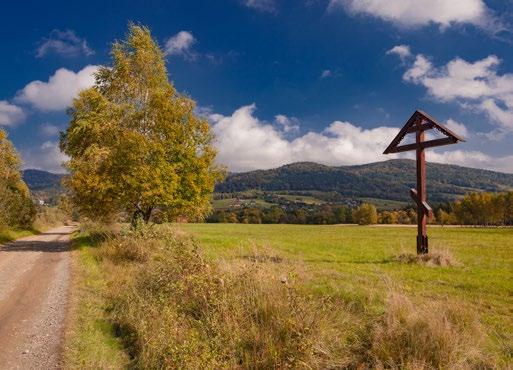

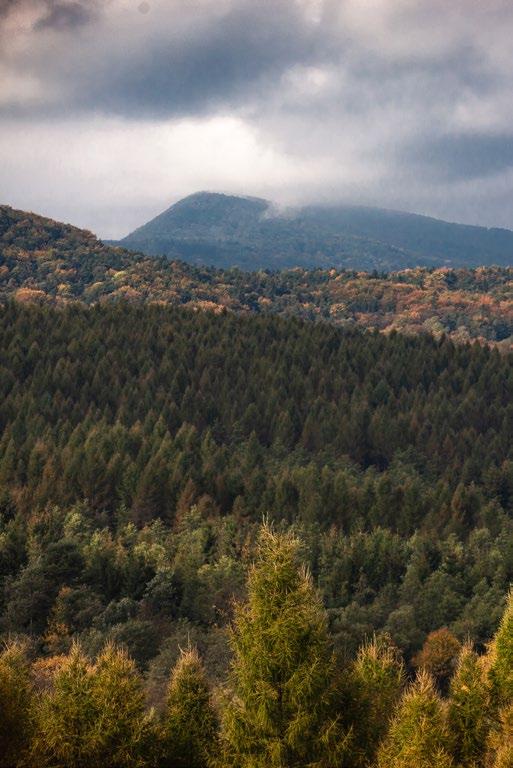
The main river of the region is the Ropa – a headwater area located on the northern slopes of the border ridge in the Low Beskids. At the height of Klimkówka (approximately 7 km northwest from Uście Gorlickie), a dam on the Ropa river was built in 1994. Klimkówka Lake, which was created at the time with an area of 306 ha, reaches the northern parts of the commune with its shores. Apart from the fact that the water reservoir has an anti-flood function, it is also an excellent place for tourism and recreation. A small storage hydropower (1.1 MW) operates by the dam.

The total area of the commune is 287.4 km². The seat of the commune, Uście Gorlickie, is in the north of this area.
 Mild hills of
Mild hills of
the
Low Beskids
Over Wysowa
Dense forests of the Low Beskids over Blechnarka
Gravel roads in the wilderness, far away from civilisation The tributaries of the Ropa River in the vicinity of Regietów
Klimkówka Lake in the vicinity of Uście Gorlickie
1
2 4 6 5 3 6 7 Uście Gorlickie LOCATION/GEOGRAPHY
The Ropa River meandering in the vicinity of Wysowa
NONEXISTENT POST-LEMKO VILLAGES
One may find abandoned villages of the Low Beskids romantic and intriguing, nevertheless, they constitute a sad consequence of the ‘Vistula’ operation from 1947. Some of them were devastated and burnt down by the army, some of them were abandoned by people who decided to leave for Ukraine or were deported to the Regained Lands. At present, very often only roadside crosses and shrines, wild orchards, wall bases of cottages, old Orthodox church sites and overgrown cemeteries remind of the previous life of this land.
It is worth visiting such places in spring when blooming fruit trees are a sole reminder of the former life of a village. The lack of lush vegetation allows us to notice the trees on the sites of households. Bieliczna and Czertyżne are great spots where we may see examples of life in the past, nevertheless, a new, tourist-oriented life is slowly making itself comfortable there.
Visiting Bieliczna, which is situated in the Biała Valley, you will be enchanted by a stone Orthodox church from 1796. Having been completely destroyed after the War, it was finally reconstructed in 1985 thanks to Mieczysław Czekaja – the parish priest of Banica. It is located in the upper part of the village and perfectly blends with the picturesque landscape. Deserted Czertyżne attracts our attention with its peacefulness, an old Orthodox cemetery and a cross at the church site.
HUCULS FROM LEMKO LAND
Associated mainly with Huculi Land, hucul ponies have been popular also in the Low Beskids for years. They are bred in Gładyszów and Regietów. These small, extremely intelligent and tough mountain ponies are one of the oldest Polish breeds. Thanks to their calm and gentle character, they will be perfect for an equine-assisted therapy.
The horse stable in Gładyszów was established in 1984. It was the largest and best centre breeding the hucul in Poland for a very long time. Due to economical difficulties, the centre went into decline but in 1993 it started to operate again. Next to the stable, there is a stylish regional restaurant, a riding school and a hotel. Apart from horse riding classes, horseback tours, carriage rides and, in winter, sleigh rides, are organised here.
The Hucul Pony Stable in Gładyszów is currently the largest stable of this type in Europe. In 2001 breeding was partially moved to Regietów where in September Hucul Days take place. During this event one may admire sports, breeding and artistic programmes.

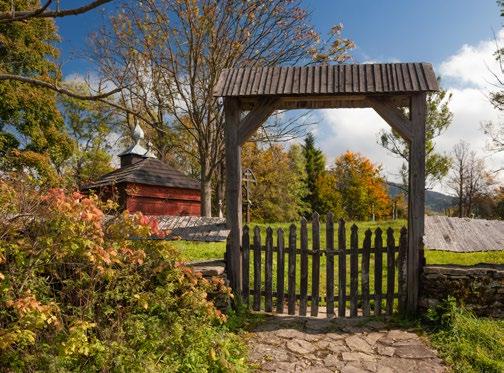

HOLY JAWOR MOUNTAIN

The Greek Catholic Sanctuary on the ridge of Jawor Mountain (720 m) – situated on the Polish and Slovak border – is a very popular place. There is the wooden Orthodox Church of Mother of God’s Protection which was erected on the site of a revelation. In 1925 Mother of God revealed herself to Glafira Demiańczyk from Wysowa. Later, the woman came back to the place to pray many times. Soon other people joined her and a cross appeared at the site. At first sceptical, the church finally gave permission to build a chapel there. The temple was erected in 1929 and its construction was funded by pilgrims. After the resettlement of Lemko people, the temple was transformed into a watchtower and the ecclesiastical equipment was burnt down. After worshippers had regained the temple in 1956, it was renovated. From 1969 to 2017 it was used by Orthodox Catholics, now it was returned to Greek Catholics. Currently, it constitutes a popular destination for pilgrims of the Eastern Church and the most significant masses are held there on 12th June and 14th October. You can get to the chapel along the red trail from Wysowa.
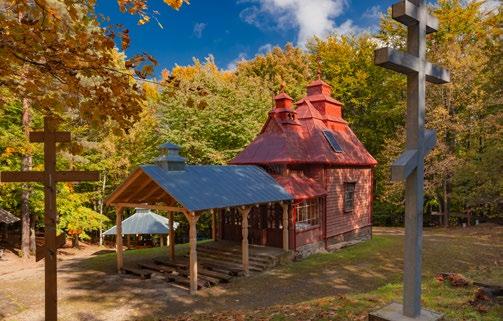

LACKOWA MOUNTAIN – THE HIGHEST PEAK Lackowa, a mountain which rises to 997 metres, is the highest mountain top on the Polish side of the Low Beskids, hence, also in Uście Gorlickie Commune. It rises over Izby and Bieliczna villages and its characteristic ‘dome’ is visible from a distance. In spite of the fact that it does not cross the height of 1,000 m above sea level, it can give a hard time! It is said that climbing it from the west along the red trail is one of the most difficult climbs in the Polish Beskids. Initially, the mountain had a Lemko name ‘Łackowa’ and today it is often called Pułaski’s Banner or Police Mountain (due to the fact that the Police emergency number in Poland is 997).
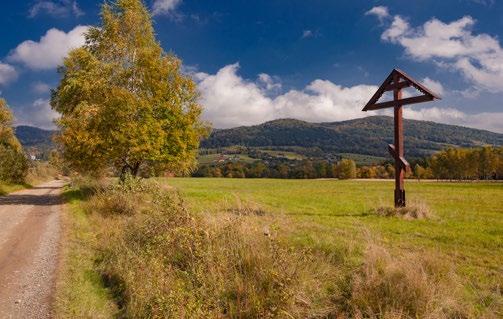

INTERESTING FACTS
1 2 4
Lackowa – a view from over Banica 7
On the way to Lackowa. Despite dense forests, we will find thinnings from which we can see even the Tatras 8
A trail which leads to Jawor Mountain 6
The chapel on Jawor Mountain 5
8 9 Uście Gorlickie INTERESTING FACTS
Hucul ponies near Regietów 3
What can be treated here?
The spa specialises in treating diseases of the respiratory system (Wysowa-Zdrój is one of the cleanest resorts in Poland), the digestive tract and the urinary system. Healing properties of waters from Wysowa manifest themselves in the process of neutralisation of the gastric acid in the stomach and the inhibition of the secretory function. That is why ‘Wysowianka’ would be a great solution in the treatment of the digestive tract diseases (peptic ulcer disease, gastritis, bile duct diseases and constipation). It also has a positive influence in the case of kidney stone disease, the urinary tract inflammation and diabetes.
What treatments?
The spa has a wide selection of treatments such as balneotherapy, hydrotherapy, kinesiotherapy, light therapy, electrotherapy, magnet therapy, heat therapy and ultrasound therapy. Wysowa-Zdrój also offers baths, massages, and inhalations with the use of local mineral waters. Peat baths are available as well. The treatment facilities are provided by local treatment centres, hotels and sanatoria. One may also take advantage of complementary Spa & Wellness treatments.
Water for health and beauty
It is worth remembering that regular intake of mineral water not only hydrates our organism but also is a great way to strengthen our bones (thanks to the content of calcium) and improves one’s fitness (magnesium and potassium). Additionally, it equals healthy and beautiful skin (beneficial electrolytes). Appropriate hydration of our body influences our attention span and mental abilities. High content of natural iodine in ‘Wysowianka’ reduces fatigue. The abundance of minerals in this water makes it highly recommended in a daily diet.
The spa among the mountains
The main town of Uście Gorlickie Commune, located by the Slovak border, is Wysowa-Zdrój. It is tucked into a mountainous valley and attracts visitors with peace and picturesque scenery. Additionally, it is one of the biggest centres of tourism in the Low Beskids.
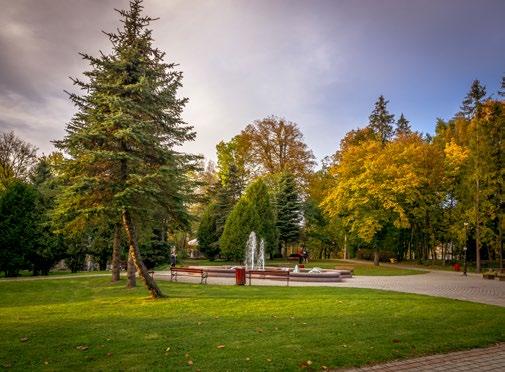
The first mention of Wysowa Spa dates back to the 17th century. Sobczak, the brigand, together with his comrades are said to have been healing with the local waters. The healing qualities of waters in Wysowa were also appreciated by Earl Maciej Lanckoroński in the 18th century who claimed that annual baths in the waters had hardened his body.
The year 1812 is regarded as the beginning of the spa character of the place. In this year, a local economist, Ignacy Zychowicz, constructed a spa building with 6 bathrooms and 9 rooms. Soon, the first guest houses appeared. Wysowa started attracting health visitors and since the paved road from Ropa appeared (1876) people could witness a dynamic development of the resort. New wooden buildings of the spa were constructed gradually. Moreover, a stylish water pump room was built according to the design of Karol Stryjeński.

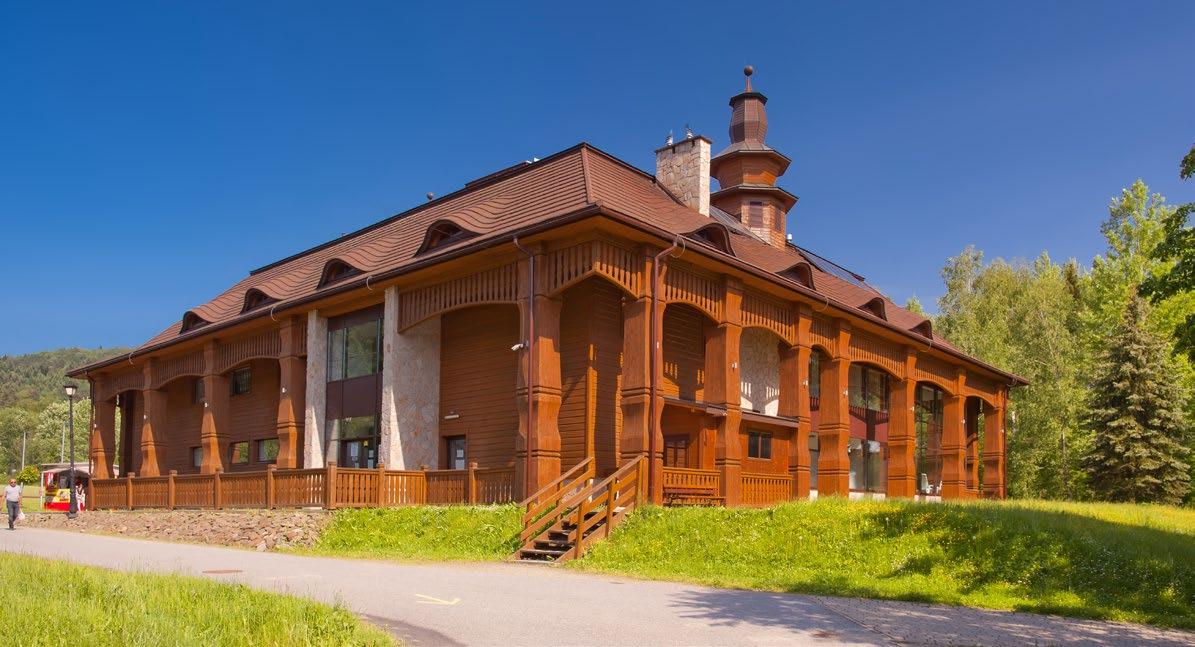
In the 1880s the exploration of local mineral waters was launched. From 1887 ‘Józef’, ‘Olga’, ‘Rudolf’, ‘Bronisław’ and ‘Słony’ were bottled.
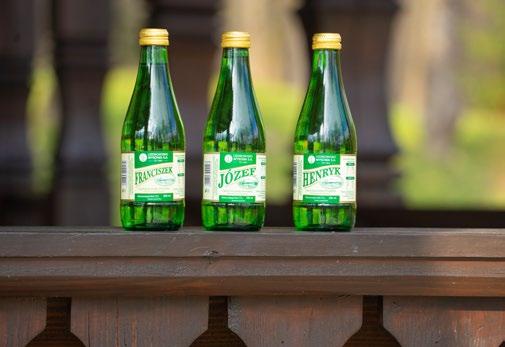
Wysowa-Zdrój had its period of prosperity before the First World War. The high quality of its mineral waters was appreciated at national expositions (awards from Przemyśl and Cracow).
The resort was destroyed during the First World War after which the land was bought by the partnership of doctors from Cracow with Dr W. Kraszewski in the lead. Thanks to their endeavours, the spa infrastructure was rebuilt. Unfortunately, another war caused large-scale destruction and Wysowa itself became a military base for the German army, including the border patrol.
After the Second World War, the spa fell into oblivion. In 1959 ‘Wysowa Spa’, a national company, was created and brought the spa back to life. In the 1960s and 1970s the majority of sanatoria were erected. After 1999, the company was bought by a joint entity of Polish companies.
At present, Wysowa-Zdrój is popular and enjoys recognition among health visitors and tourists. The spa offers 14 mineral water intakes and these are, first and foremost, acidulous sodium-hydrogen-carbonate-chloride and sodium-carbonate-calcium waters. Furthermore, Wysowianka contains a lot of natural iodine, especially vital as mountainous air lacks this element. On the basis of local springs, ‘Wysowianka’ mineral water is still produced here.
the Mineral Water Pump Room in Wysowa-Zdrój The Spa Park in Wysowa-Zdrój
SPA
Bottled mineral water from Wysowa
1 2 3 10 11 Uście Gorlickie SPA
The Water Park in Wysowa-Zdrój
The Mineral Water Pump Room was commissioned in 2006. It is a reconstruction of a former building which burnt down in the 1960s. The first Mineral Water Pump Room was erected probably in 1923 according to the project of a well-known architect from Cracow – Karol Stryjeński. The water from 5 intakes was served to visitors
by ladies in folk costumes. The current Mineral Water Pump Room fits perfectly into the infrastructure of the Spa Park in the centre of Wysowa. You can taste water from the following springs: Anna, Franciszek, Henryk, Józef II and Słone. Nearby, there is a bottling plant and numerous springs.

The most popular water springs from Wysowa
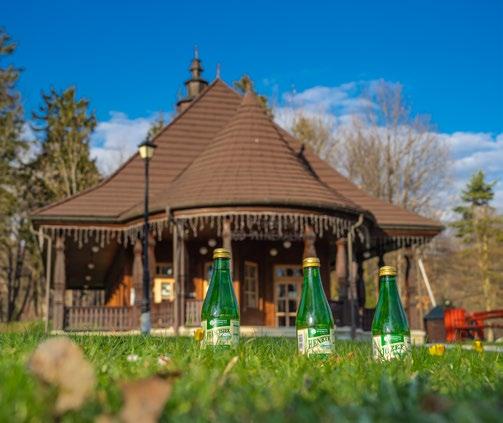
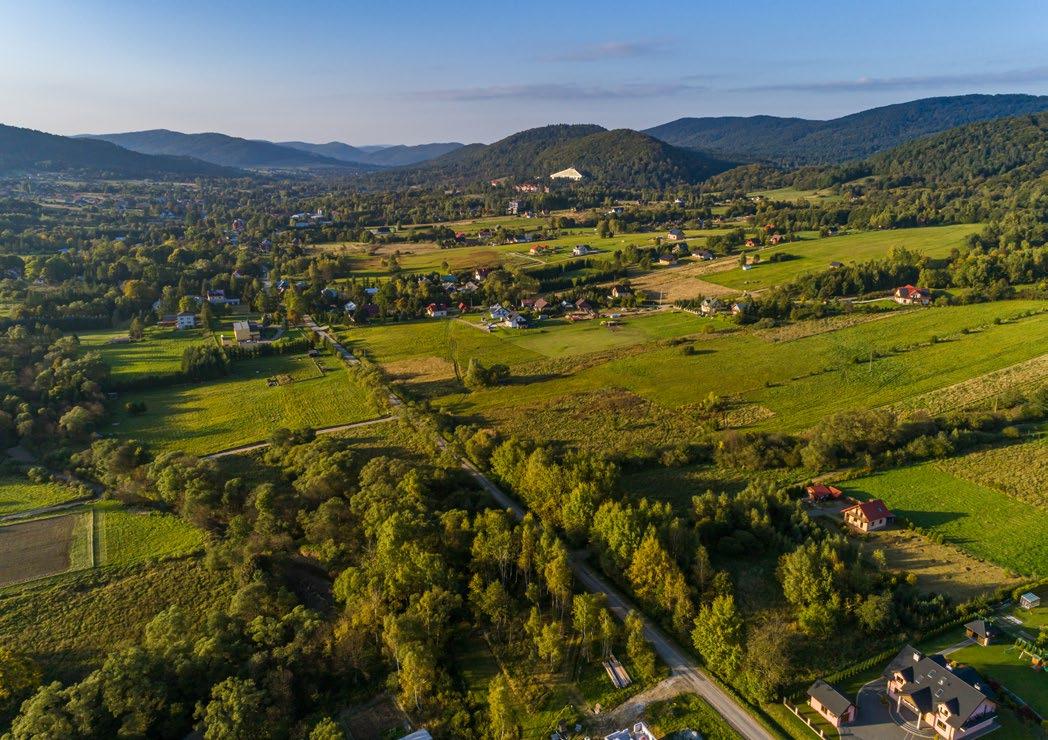
FRANCISZEK – highly mineralized acidulous sodium-bicarbonate-chloride-bromide-iodide water. It accelerates digestion and improves metabolism. It soothes ailments connected with peptic ulcer disease. It is particularly recommended in the case of bile duct diseases. It also relieves symptoms of a hangover. The spring was named after Franciszek Kokot – an outstanding nephrologist, a professor of the Medical University of Silesia.
JÓZEF I – mineral water which is highly recommended in the treatment of urological problems. It will serve great in the inflammation of the urinary tract, kidney stone disease or gout.

HENRYK – acidulous sodium-bicarbonate-chloride-bromide water excellent for any conditions connected with the stomach. It is especially recommended for those who suffer from hyperacidity and iodine deficiency. It also brings relief in the case of peptic ulcer disease, metabolic disorders and bile duct diseases. It lowers sugar level in blood. The spring was named after Henryk Świdziński, an expert on the Carpathians and their mineral waters, an explorer of the region of Wysowa and a professor of AGH University of Science and Technology.
 The Mineral Water Pump Room in Wysowa-Zdrój
The Mineral Water Pump Room in Wysowa-Zdrój
Wysowa-Zdrój abounds in healing mineral waters and within its area we will find fourteen mineral water intakes 1 2 13 12 Uście Gorlickie SPA
Other springs: Aleksandra, Józef II, Słony, Anna, Bronisław
Cemeteries from the First World War

During the First World War the front ran across the Low Beskids due to the fact that Russians wanted to break the barrier of the Carpathians. Fierce battles in the region lasted from winter 1914 to spring 1915. From 2nd to 5th May the Austro-Hungarian army at Gorlice-Tarnów offensive managed to crush the resistance of Russians. Numerous temporary graves were left in the mountains after those dramatic fights. To order them, the Department of War Graves was created and 10 grave areas were distinguished. Each of them had their own artistic executive.
On Rotunda Mountain (771 m), which is located east from Regietów, you can see a representative military cemetery for the first area whose artistic executive was Dušan Jurkovič – an outstanding Slovak architect. He



mainly used wood and the style of the cemetery is said to be proto-Slavic. The cemetery on Rotunda is considered the most beautiful of all military cemeteries. Jurkovič placed all his cemeteries on tops or slopes of mountains so that they would be visible from a distance. After the resettlement of Lemko people, when the area of the Low Beskids became deserted, the cemeteries started to overgrow and fall to ruin. The necropolis on Rotunda was also eaten by the tooth of time. The reconstruction works started in 1995 and finished in 2018. Nowadays the cemetery presents itself majestically and it is worth going for a short walk there along the red trail from Regietów.
Tolvaj (the Brigands from the Carpathians)

Due to its cross-border location and the trade route which went through the valley of the Ropa River, the area was popular among brigands in the 17th century. Manors and clergy houses were plundered. Merchants who wandered through Beskid passes were deprived of their goods. Brigandage became a serious problem on both sides of the border. Robbers were not scared off by severe punishment (death penalty the most often) or brutal torture. In court files in Biecz, we can still find the names of brigands from numerous villages in the commune (Zdynia, Gładyszów, Hańczowa among others). According to the legends, on the eastern slopes of Ostry Wierch there was a cave – Brigand Cave – in which brigands kept their treasure. Currently, it is a small pit covered with rock debris but still available to visitors.
Confederate Trenches
The Bar Confederation, formed in Bar, in Podolia in 1768, was a strong patriot movement against domination of the Russian. Dukla became one of its most significant centres in the Low Beskids. After the fall of Confederate centres in Bar and Cracow, the Carpathian border came to be a very active area. The vicinity of Konieczna, Wysowa, Blechnarka, Izby and Muszynka were active as well. Towering over the region, Lackowa Mountain was called Pulaski's Banner – after the leader of Confederates, Kazimierz Pułaski. By means of flag signals from mountain tops, two camps of Confederates – in Izby and Blechnarka – were supposed to communicate. The outline of the trenches is visible till today and it was placed under protection over Muszynka and at the foot of Lackowa (these survived to the 1980s) by creating Confederate Trenches Reserve.
1200
1359
the land comprising the valley of the upper Ropa River and Zdynia village was granted by Casimir III the Great to Jan Gładysz – the foundation of so-called ‘Dominium Ropae’.
1926 1947 1994 1876 2013 1700 1800
1770
1900
the Bar Confederation, the battles of Polish nobles against the Russian army in the vicinity of Izby, Wysowa and Konieczna.
the Schism of Tylawa i.e. the split of the Eastern Church (a conversion wave from Greek Catholic Church to Eastern Orthodoxy).
the ‘Vistula’ operation, involuntary resettlement of Lemko people to the Regained Lands and the north-east of Poland.
the construction of a paved road from Ropa to Wysowa, the commencement of dynamic development of the resort.
the Orthodox Church of St. Paraskeva in Kwiatoń and the Orthodox Church of St. Michael the Archangel Church in Brunary were listed as UNESCO sites.
1300
the creation of Klimkówka Lake on the Ropa River – a dam which also serves an entertainment and recreation purpose.
1914-1918
the First World War, the Low Beskids (including Uście Gorlickie Commune) witnessed the change of frontlines and the groundbreaking Gorlice-Tarnów offensive.
Rotunda – a military cemetery near Regietów
Pod Ostrym wierchem
The celebration of Confederate May Mass
History
1400 1500 the 15th century
the second half of the 17 th century
the 16th century
the development of settlements in the region under the Vlach law, the development of herding in the Low Beskids.
the invasion of the Transylvania army.
2000 1 2 14 Uście Gorlickie HISTORY 15
the development of brigandage due to the cross-border location.
1600
Lemko Saint
Maksym Sandowycz (Maksym Gorlicki), a priest of Lemko origin, converted into Orthodoxy. He promoted Eastern Orthodoxy among Greek Catholics from Galicia. Sandowycz acted in spite of bans for what he had to pay fines and was even arrested. In 1914 he was shot during a wave of repression towards those who were suspected of pro-Russian attitudes.
Soon after the Schism of Tylawa, the cult of Sandowycz was widespread. He was presented as a fighter for the independence of Lemko people and considered to be a spiritual leader. In 1994 he was canonised by the Polish Autocephalous Orthodox Church. His grave is located in Zdynia and his relics were moved in 2007 to the Holy Trinity Church in Gorlice.


Thalerhof
Thalerhof was an internment camp for Ruthenians from Galicia and Bukovina who were accused of moscophilia. They were arrested mainly at the beginning of the First World War.
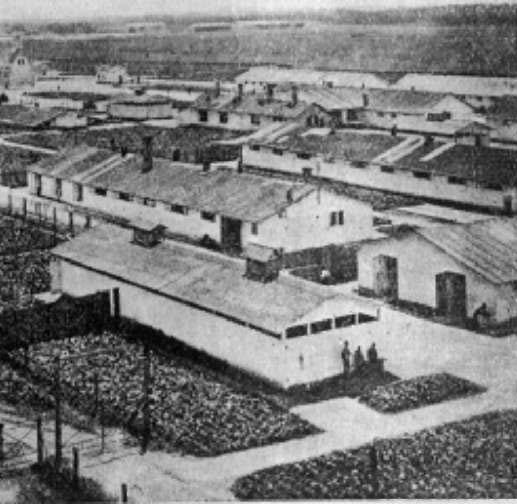
The camp was created by Austro-Hungarian authorities within the area of the military airport close to Graz in the years 1914-1917. The prisoners were detained in very harsh conditions (hunger, poor sanitary conditions, terror). Initially, they stayed outdoors. Later on, they were placed in tents or hangars. Almost the whole Lemko intelligentsia with Rusophile views were among the victims (priests, cultural activists).
The camp was closed in May 1917 by order of Charles I of Austria. The exhumed were buried in a collective grave in nearby Feldkirchen. ‘The Cult of Thalerhof’ was propagated in Galicia after the First World War and, as a consequence, reunions were organised, books and diaries were published.
The ‘Vistula’ Operation
It was a tragic, forced resettlement operation, a true doom of Lemko land. The biggest tragedy of Lemkos in the Low Beskids which irrevocably changed the character of these mountains.

The operation was conducted in 1947, nevertheless, some previous resettlements to Ukraine were carried out (they were said to be voluntary but in reality they were lined with Soviet propaganda). In 1945 the deportations ceased to be voluntary and the army joined the action. The operation aimed at Ukrainians and Ruthenians and the main differentiating criterion was faith. The remaining people were deported in 1947 to Western Lands (Lower Silesia, Opole Land, Zielona Góra Land) and Northern Lands (the vicinity of Stettin) and the whole operation was extremely violent.
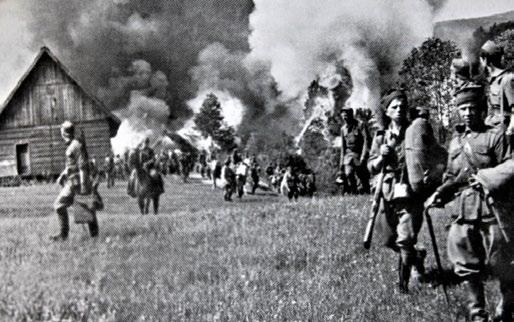
In 1956 a lot of Lemko people came back to their home land, although, in many cases there was nothing to come back to – their households or the whole villages were either destroyed or settled by the Polish.
Nowadays Lemko people, after years of hiding, are able to speak their language, go to their church and cultivate their traditions again. The Low Beskids are partially the Lemko Beskids again.
 The grave of priest Maksym Sandowycz
The Cathedral of the Holy Trinity in Gorlice
Talerhof Camp in 1917. Source Wikipedia – public domain
Mild hills of the Low Beskids and historic Orthodox churches
The grave of priest Maksym Sandowycz
The Cathedral of the Holy Trinity in Gorlice
Talerhof Camp in 1917. Source Wikipedia – public domain
Mild hills of the Low Beskids and historic Orthodox churches
1 2 3 1
16 17 Uście Gorlickie HISTORY
The ‘Vistula’ Operation in Rzeszów Land. Public domain ©Jan Gerhard
2
The Spa Park and the Mineral Water Pump Room

These are the most commonly visited places in Wysowa. You will find there local, mineral water springs of various compositions and flavours. Some of them are open-access and some are only available in the Mineral Water Pump Room which towers over the Spa Park. A stylish building is a reconstruction of a former one and blends with the character of the place. The Old Spa House – currently a restaurant and a hotel – is located in the Spa Park.
Wysowa-Zdrój
The spa centre of the commune
This charming town by the Ropa River is also one of the main centres of tourism in the Low Beskids. However, let us not be deceived by this fact as the atmosphere here is peaceful and cosy. Wysowa, surrounded by steep slopes of the Hańczowskie Mountains, constitutes an excellent place for taking a rest. Moreover, it is a great starting point for trips in this part of the Beskids.

Being situated close to the border with Slovakia, it has always taken advantage of its location. In the distant past, quite a popular trade route through the Carpathians ran here. Location by the border was also essential during the First World War when the Russian army stormed the Carpathian passes and in the vicinity of Wysowa and
Blechnarka the war front stopped for three months in 1915. During the Second World War, the German army stationed in Wysowa-Zdrój. After the war, numerous Lemko families from Wysowa left for the Soviet Union, surrendering to Soviet propaganda. Solely Polish or mixed families remained in the town as a result of forced resettlement which was a part of the ‘Vistula’ Operation.
At present, Wysowa attracts people with its intimate atmosphere and peacefulness. It is attractive for both health resort visitors and tourists who choose the place eagerly.

Temples in Wysowa-Zdrój
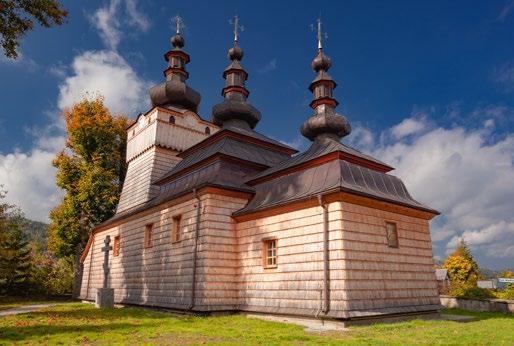
Charming and unusually picturesque architecture of Orthodox churches is inextricably linked with the Low Beskids and you will find a plethora of its examples in Uście Gorlickie Commune. However, not all of the temples survived till today. A lot of them were burnt down in the 1940s or dilapidated in the course of time. The ones which were adapted by Roman Catholics after the resettlement of Lemko people had better luck and their ecclesiastical equipment was not robbed. In some of them masses in the Eastern rite are still held and it would be a very interesting experience (not only religious, but also
cultural) to take part in them. Within the commune, wooden churches prevail. Most of them are of northwest type. An interesting exception is Gladyszów where you can come across an atypical for the region church in a Ukrainian style (built on a Greek-cross plan). All the churches are sites of the Wooden Architecture Route. Moreover, the Orthodox Church of St. Paraskeva in Kwiatoń and the Orthodox Church of St. Michael the Archangel Church in Brunary were listed as UNESCO sites.
 A view of the spa heart of Wysowa-Zdrój – a complex of sanatoria which towers over the town
A view of the spa heart of Wysowa-Zdrój – a complex of sanatoria which towers over the town
18 Uście Gorlickie WYSOWA-ZDRÓJ 19
The Orthodox Church of St Michael the Archangel in Wysowa The Church of the Assumption of Virgin Mary in Wysowa-Zdrój
The Orthodox wooden Church of St. Michael the Archangel in Wysowa-Zdrój


The temple dates back to 1779. It is said to have burnt down in the 19th century during the battles of Confederates who, later on, rebuilt it, nevertheless, the information has not been confirmed. The interior of the temple is decorated with the polychromy which dates back to 19121913. The ecclesiastical equipment is from the 18th and 19th century. The interior contains late-Baroque iconostasis with a set of well-maintained icons. As many other churches in the region, this one is included in the Wooden Architecture Route. A pentecostal church functions next to it.
Spa architecture
The Parish Church of the Assumption of Mary
In the north of Wysowa there is a wooden Roman Catholic church which was erected in the years 1936-38 according to the design of a well-known architect, Zbigniew Mączyński. It stands out with its interesting but not very typical post-frame construction. The design refers to old buildings of the region. The church is a site of the Wooden Architecture Route.
The Spa Chapel of Transfiguration of Jesus
The chapel was built in the 1980s. Its interior hides the altar of Saint Hubertus – especially valued by local hunters. There is also a cross which commemorates the visit of Pope John Paul II in nearby Hańczowa. A monument of the Pope is situated in front of the chapel.

Local architecture definitely deserves our attention. Until today we can admire a few wooden buildings from the Interwar Period – located close to the Orthodox church, a former post office and the seat of the General Corps of Volunteer Firefighters which now serves as the Centre of Tourist and Cultural Product of the Gorlicki Beskid.
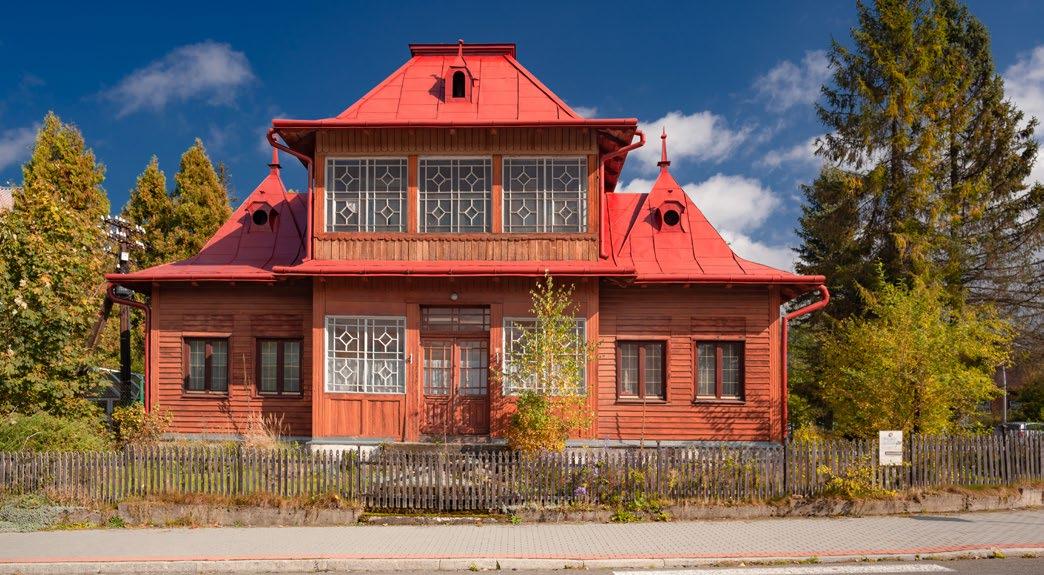
Villages of Lesser Poland which smell of herbs
Selected agrotourism farms in Wysowa-Zdrój and Banica are on ‘Villages Smelling of Herbs in Lesser Poland’ Route. The route associates attractively located agritourism places which specialise in growing and using herbs. The farms have a wide offer connected with herbs, regional cuisine and even a rich selection of spa treatments. ‘Villages of Lesser Poland which Smell of Herbs’ event takes place in the amphitheatre of the Spa Park in Wysowa-Zdrój in August. This is a feast of the region, tradition and nature! Local herbs, which have been used here for ages, regional traditions, local artists and hostesses are in the spotlight. The event is the culmination of everything which has happened for the whole year in Wysowa-Zdrój and on ‘Villages Smelling of Herbs in Lesser Poland’ Route.
The agenda of the event includes lectures on herbs, an exhibition of herbs with a possibility of buying them, a fair of books on herbs, a show of artistic handicrafts, regional cuisine stalls and performances of regional bands.
Opposite the centre, a former clergy house rises (till 1995 it served as a watchtower of Border Protection Troops). South of the former manse, a building of an old Lemko cooperative ‘Jednist’ and a former school are located.
 The historic building of the former post office
The historic building of the former post office
1 1 2 2 3 20 Uście Gorlickie WYSOWA-ZDRÓJ 21
Uście Gorlickie and forgotten villages
By Klimkówka
In spite of the fact that Uście Gorlickie is the seat of the commune, Wysowa-Zdrój is the most popular place in the region. However, it is worth stopping in Uście Gorlickie to contemplate its uneasy history. Initially, the town belong to the Gładysz family and, later, fell into the hands of the Trzyciescy family among whom there was Tytus Trzecieski – next to Ignacy Łukasiewicz and Karol Klobassa, one of the pioneers of oil industry in Galicia.
At first, the place was called Uście Wołoskie (the 17th century), a century later it gained a name Uście Ruskie. The name Uście Gorlickie has been used since 1952. During the Interwar Period, Uście became one of the main social centres in the western Lemko region. After the relocation of Lemko people in 1947, the town was the only population centre in this part of the Beskids. After 1956 a lot of Lemko people came back – due to this fact a Lemko character of the region has been preserved. Uście Gorlickie is the only commune in the Low Beskids inhabited in majority by Lemko community.
In the heart of the town, our attention is drawn to the monument of Lemko people who died in the battle with the Nazi occupants during the Second World War. You will find here a cemetery from the period of the First World War. It is worth visiting the Orthodox Church of St. Paraskeva from 1796 which after the war functioned as a Roman Catholic church. Currently, it belongs to the Orthodox Church again. Religious diversity of Uście is completed by the Pentecostal church.
Along the route of Orthodox churches

Orthodox churches are an integral part of the Low Beskids. Blended with the landscape, these architectural pearls witnessed the complicated history of this land. The majority of them are wooden so they are included in the Wooden Architecture Route. A real pearl is the Greek Catholic Parish Church of St. Paraskeva in Kwiatoń dating back to the second half of the 17th century and the Greek Catholic Parish Church of St. Michael the Archangel in Brunary. Both were listed as UNESCO sites in 2013.
In some villages we may come across stone temples. The renovated Orthodox church in Bieliczna from 1796 seems to be an integral part of the quiet valley of the Biała River. The outline of the Church of St. Luke the Evangelist in Izby (1886) can be seen from nearby hills.
This is a place where up to the first half of the 20th century pilgrims flocked to see the miraculous image of Bogurodzica (the Mother of God) who is said to have provided her support to Kazimierz Pułaski. Wołodymyr Chylak, a well-known Lemko writer who created his works under the pseudonym Jeronim Anonym, used to be a parish priest in Izby. Another stone church can be found in Blechnarka – the Orthodox Church of Sts Cosmas and Damian which dates back to 1801. Until 1947 it was a Greek Catholic church, later, it was transformed into a sheepcote. In 1958 the church was given to the Eastern Orthodox Church.

Lemko ‘Watra’ (Watchfire) in Zdynia
It is an annual celebration of Lemko culture. Initially, it was organised in Czarna, close to Uście Gorlickie, later in Hańczowa and Bartne. Since 1990 it has taken place in Zdynia, in a centre built especially for this occasion and created by the Union of Lemko People. At first, it was a small and informal event but with time it developed into a huge international festival whose main aim is the integration of Lemko people resettled and dispersed all over the world as a result of the ‘Vistula’ Operation in 1947.
This three-day event is an excellent occasion to present the rich cultural heritage of Lemkos (performances of folk and modern groups, anniversary celebrations, workshops, exhibitions). There is no lack of stalls with handicrafts and Lemko literature. However, first and foremost, it is a great chance to meet former residents of the Low Beskids. ‘Watra’ gathers Lemko communities either from Poland or abroad (Slovakia, Ukraine, the USA and Canada among others). Moreover, it is extremely popular with tourists. Its prestige is emphasised by visits of important people from the world of politics and culture.
Nowica
Located at the foot of Magura Małastowska, Nowica attracts people with its calm and peaceful atmosphere. Even though all its inhabitants were resettled, a part of families came back after 1956. Today, delighted with the local landscape, people from various parts of Poland are joining them.
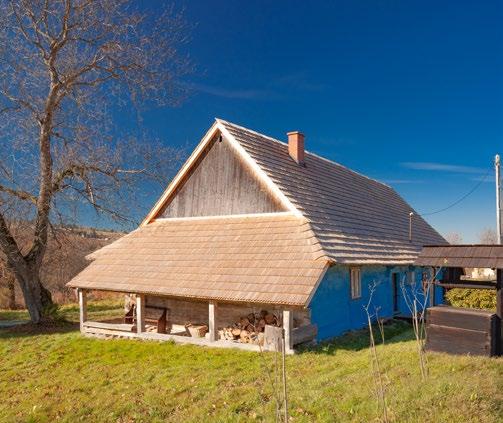

A lot of traditional Lemko cottages, chyże (Lemko farmstead) and St Paraskeva Greek Catholic Church from 1843 have been preserved in the village. Masses in the Greek Catholic rite are held in this church. In the Falling Asleep Mother of God shrine an annual Greek Catholic fair is organised on 28th July.
In the past, inhabitants of Nowica were famous for their wooden crafts (spoons, rolling pins, spindles). Luckily, the tradition survived to this day and in some households, one may purchase wooden spoons, although their manufacturing has been mechanised.
Bohdan Ihor Antonycz (1909-1937), a Ukrainian poet, is also connected with Nowica – he was born in this very place. In the village, you will find his monument. Next to the monument, there is a Greek Catholic presbytery in which, since 2004, a brotherhood of Greek Catholic youth ‘Sarepta’ has been functioning.
Nowica is also known for having organised Theatre Meetings since 2008. They are held by Nowica Friends Association in cooperation with artistic and musical collective ‘Nowica 9’ and friends from agrotourism farm ‘Nowica 21’. It is a non-commercial event and a huge artistic phenomenon not only in the region.
The Orthodox Church of St Paraskeva in Nowica
A Lemko cottage in Nowica
1 2 3 22 Uście Gorlickie UŚCIE GORLICKIE AND FORGOTTEN VILLAGES 23
the Orthodox Church of St Paraskeva in Uście Gorlickie
Lackowa and Busov
Besides limited views from the top, getting to the top of Lackowa (997 m) – the highest mountain in the Low Beskids on the Polish side – is definitely worth our effort. Its western slopes will satisfy those who doubt a mountainous character of the lowest of the Beskids. You can get there along the green trail from Wysowa.
While staying in Wysowa, it is a good idea to visit our southern neighbours. The green trail leads first from the resort to the border where yellow signs and again green ones lead us to the top of Busov (1,002 m) – the highest mountain in the Low Beskids. You can come back along the same route or take a loop through Vyšný Tvarožec and Blechnarka.
Kozie Żebro
One more interesting ridge which debunks a myth of the Low Beskids being gentle and boring is Kozie Żebro (Goat Rib). Its massif which rises over Wysowa may surprise us the way Lackowa does. Although it is not very high (847 m), it has very narrow, steep slopes. The mountain was named by Austrian cartographers who found there a skeleton of a deer colloquially called a goat. You can get there from Wysowa following the green trail.
On foot
The commune is crossed by a network of various tourist trails with a total length of 900 km which gives us plenty of possibilities to hike. Due to the border location of the commune, it is also worth visiting Slovakia to get acquainted with Lemko land in the southern part of the Carpathians.

The main tourist centre and, at the same time, a great starting point for hiking is Wysowa-Zdrój. It is a place with great accommodation capacity (resorts, private

apartments, agritourism farms) and good transport which facilitates the process of planning trips. In other localities, agritourism farms will serve as accomodation spots.
There is no shortage of mountain hiking trails but the Low Beskids can boast of really interesting valleys. When planning mountain trips, it is good to remember that routes lead mainly along forested ridges, very often avoiding picturesque valleys.

 Trekking in the Low Beskids
Kozie Żebro – a mountain top 1.5 h from Wysowa
Trekking in the Low Beskids
Kozie Żebro – a mountain top 1.5 h from Wysowa
Active
1 2 3 24 Uście Gorlickie ACTIVELY IN THE COMMUNE 25
Lackowa and Busov seen from Jaworzyna Krynicka (to understand the scale)
Actively in the commune
tourism meets the historical heritage of the Low Beskids at every turn
By bike
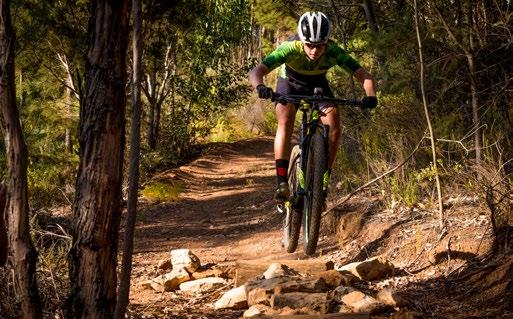
The Low Beskids are not called the Cycling Beskids without a reason. It is an excellent area for both road and MTB cycling enthusiasts. A bike is, undoubtedly, the best means of transport in this region – it will allow us to get to the places where public transport does not operate and travelling by car is too difficult. Getting to know the area from a bike saddle lets us see all the attractions located in the villages of the Low Beskids – Orthodox churches, roadside crosses, Lemko cemeteries and the ones from
the First World War. Those interested in long-distance cycling may set out on a bike trip along the Multicultural Bike Trail which is 65 km long – its name refers to the richness of various cultures in the region. The trail leads from the Wysowska Pass to Blechnarka, Wysowa and through Hańczowa, Śnietnica and Brunary to Grybów and further north to Sędziszów. The trail is relatively easy. You may only encounter some difficulties between Brunary and Grybów or riding up the Wysowska Pass.


On a horse back
Equestrian tourism is popular in the region. Hucul horse stables in Gładyszów and Regietów offer horse-riding lessons, carriage rides and snow rides in winter. For more advanced ones, horse riding tours are organised along a well-developed network of bridleways throughout the Low Beskids.


The Water Park in Wysowa-Zdrój
The Water Park in Wysowa-Zdrój is a beautifully located facility open to those who seek water attractions and relaxation. This is a rehabilitation and recreation swimming pool with an area of 287m2 and depth from 1.2 m to 1.4 m. The temperature of water reaches 30°C. The swimming pool is equipped with air coaches, a water massage wall, an air geyser, a water cannon or a water cascade for a neck massage. There is a pool for children with a water umbrella, a steam sauna, a dry sauna and a bar.
By the water

In summer, Klimkówka Lake gives us a number of possibilities to rest and relax. The water reservoir is an excellent place to do water sports such as kayaking, windsurfing and paddle boarding, which is becoming more and more popular. Changing winds over the lake will be appreciated by sailors as well.
 A seasonal student campsite in Regietów
A seasonal student campsite in Regietów
1 2 3 4 1 2 3 26 Uście Gorlickie ACTIVELY IN THE COMMUNE 27
The Low Beskids have a dense net of wonderful, forest routes
Snowtubing
In good winter weather (a lot of snow and frost), we will be able to try out snowtubing in Smerekowiec, close to the ski station. It is a great form of entertainment for either adults or children. We ride down very fast on a specially prepared dinghy and go up by a ski lift.
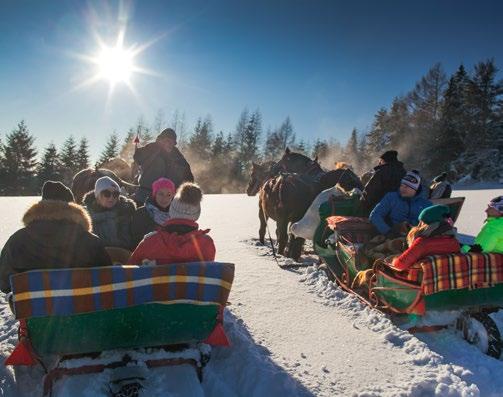
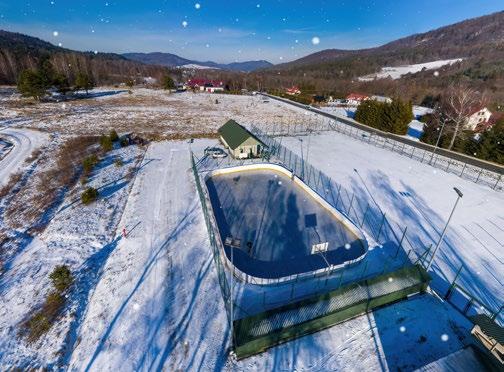
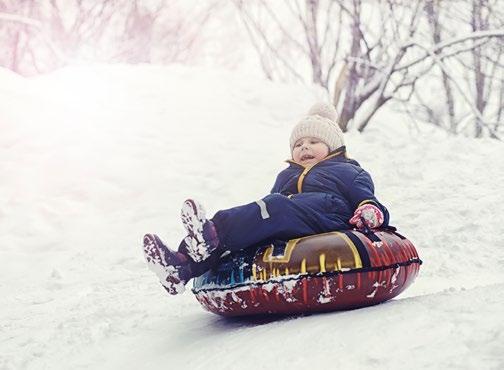
Actively in winter
Smerekowiec Ski Station
Smerekowiec Ski Station is a small ski station in the Low Beskids located 8 km from Uście Gorlickie. Skieres can use a single T-bar lift. The ski run is 650 m long (a training ski run is 100 m long). It is groomed daily, snowed and lit. If there is a lot of snow, snowtubing is open by the station. In a regional restaurant, one may eat a meal and stay overnight.


Snow Rides
Snow rides in the Low Beskids are extraordinary. In the vicinity of Regietów and Gładyszów there are stables of hucul ponies where real rides on large sleighs are organised. Sleighs run through Beskid forests, among trees covered in snow under the starry sky and we can hear snow crunch. During rides for children there is always time to play in snow and have a bonfire. For adults who choose night rides, sleighs are equipped with torches. After a snow ride, a regional feast with Lemko food is organised. If you want to go on such a snow ride, visit the Stable of Huculs ‘Gładyszów’ and ‘Stara Cegielnia’ (the Old Brickyard Stable) in Gładyszów.
Ice rink
In winter time, when the temperature falls below O°C a seasonal ice rink (18x30 m) is opened on the ground of a sports field. There is an ice skate rental by the rink.
Cross-country skiing

IZBY – LACKOWA – IZBY 12 KM
The trail starts in a small village of Izby and leads to the highest peak of the Low Beskids – Lackowa. It is almost completely wooded (as the whole Low Beskids). A forest road leads us from Izby to the Beskid Pass. From the Pass, along the red trail, we move towards Lackowa. The climb to the peak is very steep. We ski down to the Pułaski Pass and climb up Ostry Wierch. We ski down along the yellow trail in the direction of Stożek (climb) and from there we come back along a forest road to Izby.
WYSOWA-ZDRÓJ
The trail starts in Wysowa, in the valley of the Łopaciński Creek. We walk the forest road along the creek to Kozie Żebro (in good weather we may see the Tatras). We ski down along the same road or take a very steep downhill to Regietów or Hańczowa.
 – KOZIE ŻEBRO – WYSOWA-ZDRÓJ 6 KM
– KOZIE ŻEBRO – WYSOWA-ZDRÓJ 6 KM
1 2 3 3 4 1 2 28 Uście Gorlickie ACTIVELY IN WINTER 29
The project ‘The support of small and medium-sized enterprises which operate in tourism and increasing the recognisability of Lesser Poland as a tourist economic brand’ (nr RPMP.03.03.01-12-0593/18) co-funded by the European Union as a part of the Regional Operational Programme of Lesser Poland for the years 2014 – 2020.
the Foundation for the Development of Regions

www.f-rr.org

the Association of Polish Spa Communities

www.sgurp.pl
 The project IS co-funded by the Regional Operational Programme of Lesser Poland for the years 2014 – 2020. The support of small and medium-sized enterprises which operate in tourism and increasing the recognisability of Lesser Poland as a tourist economic brand.
The project IS co-funded by the Regional Operational Programme of Lesser Poland for the years 2014 – 2020. The support of small and medium-sized enterprises which operate in tourism and increasing the recognisability of Lesser Poland as a tourist economic brand.
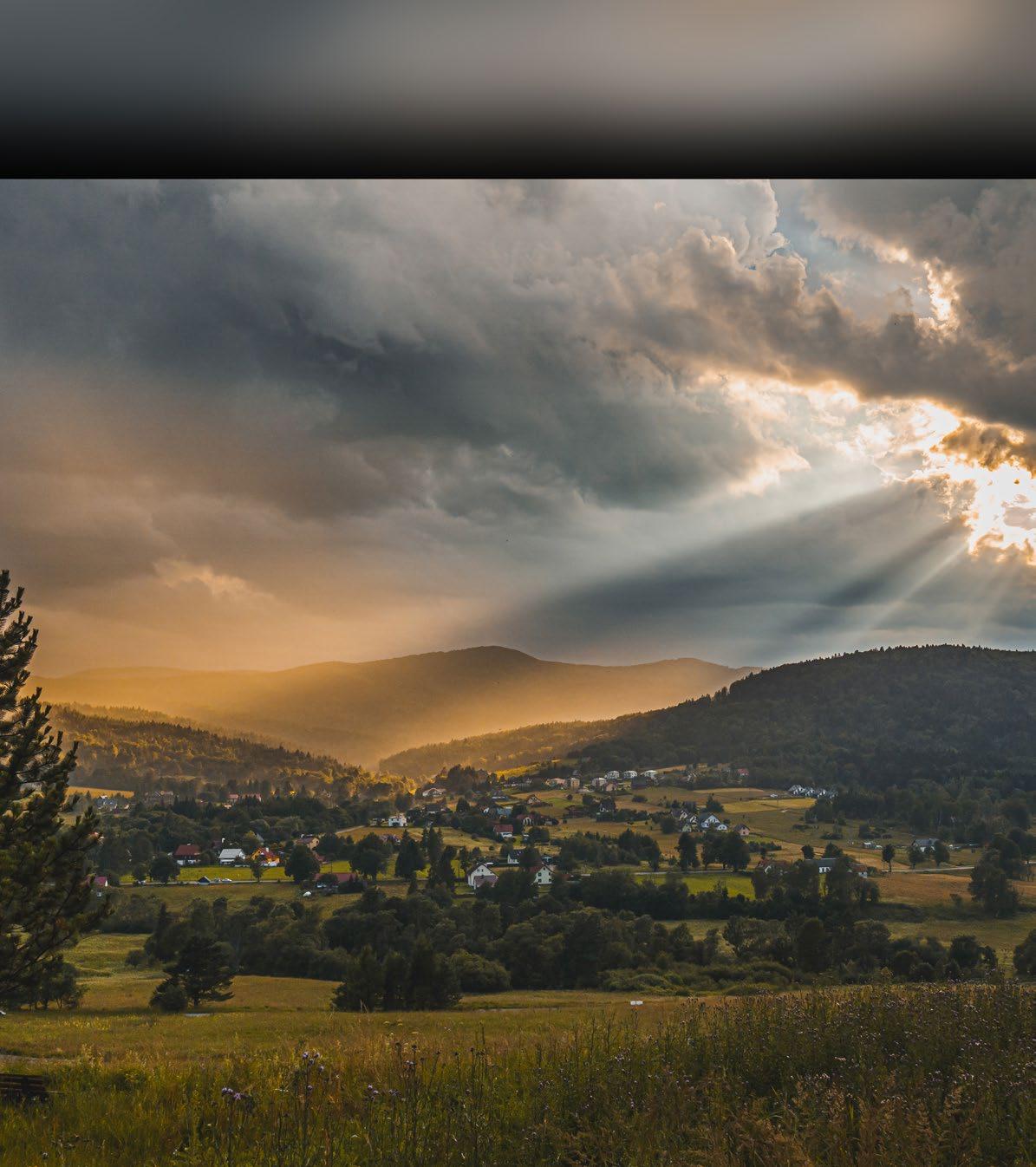



 The project IS co-funded by the Regional Operational Programme of Lesser Poland for the years 2014 – 2020. The support of small and medium-sized enterprises which operate in tourism and increasing the recognisability of Lesser Poland as a tourist economic brand.
The project IS co-funded by the Regional Operational Programme of Lesser Poland for the years 2014 – 2020. The support of small and medium-sized enterprises which operate in tourism and increasing the recognisability of Lesser Poland as a tourist economic brand.

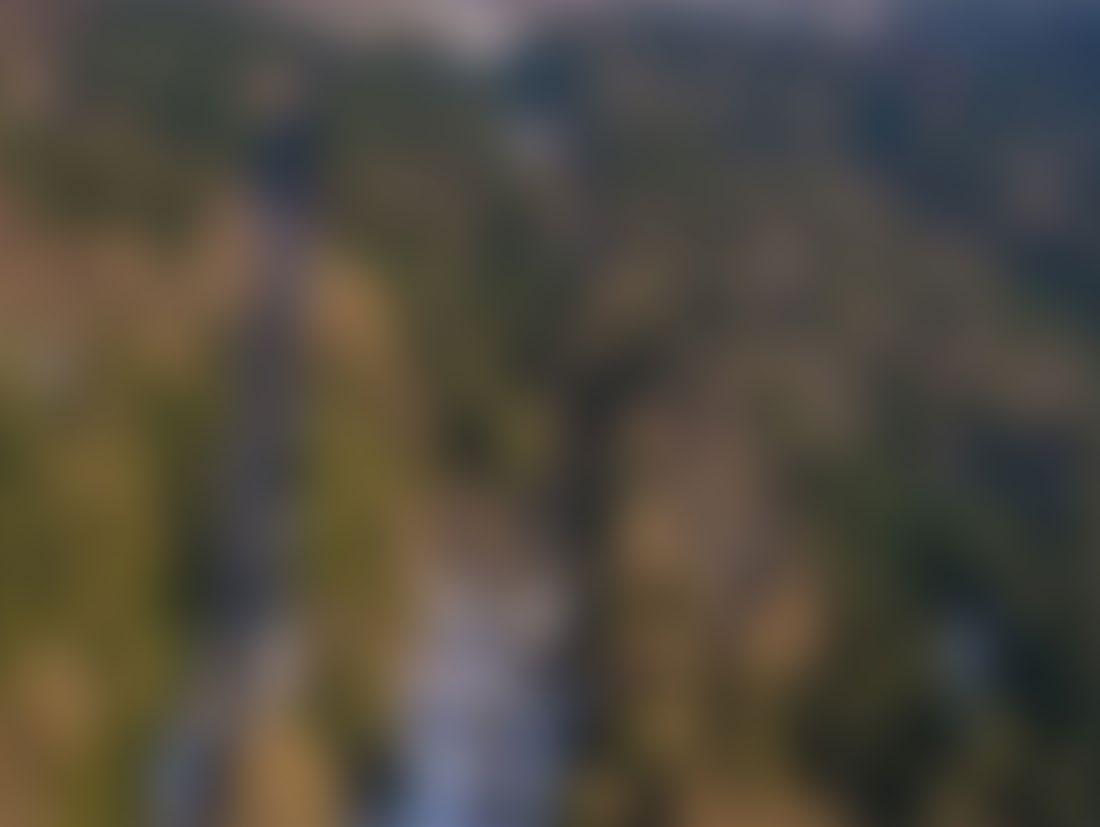














 Mild hills of
Mild hills of
















 The Mineral Water Pump Room in Wysowa-Zdrój
The Mineral Water Pump Room in Wysowa-Zdrój










 The grave of priest Maksym Sandowycz
The Cathedral of the Holy Trinity in Gorlice
Talerhof Camp in 1917. Source Wikipedia – public domain
Mild hills of the Low Beskids and historic Orthodox churches
The grave of priest Maksym Sandowycz
The Cathedral of the Holy Trinity in Gorlice
Talerhof Camp in 1917. Source Wikipedia – public domain
Mild hills of the Low Beskids and historic Orthodox churches




 A view of the spa heart of Wysowa-Zdrój – a complex of sanatoria which towers over the town
A view of the spa heart of Wysowa-Zdrój – a complex of sanatoria which towers over the town




 The historic building of the former post office
The historic building of the former post office







 Trekking in the Low Beskids
Kozie Żebro – a mountain top 1.5 h from Wysowa
Trekking in the Low Beskids
Kozie Żebro – a mountain top 1.5 h from Wysowa






 A seasonal student campsite in Regietów
A seasonal student campsite in Regietów






 – KOZIE ŻEBRO – WYSOWA-ZDRÓJ 6 KM
– KOZIE ŻEBRO – WYSOWA-ZDRÓJ 6 KM
 The project IS co-funded by the Regional Operational Programme of Lesser Poland for the years 2014 – 2020. The support of small and medium-sized enterprises which operate in tourism and increasing the recognisability of Lesser Poland as a tourist economic brand.
The project IS co-funded by the Regional Operational Programme of Lesser Poland for the years 2014 – 2020. The support of small and medium-sized enterprises which operate in tourism and increasing the recognisability of Lesser Poland as a tourist economic brand.

